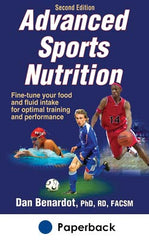Training for sports requiring power
This is an excerpt from Advanced Sports Nutrition-2nd Edition by Dan Benardot.
Sports Requiring Power and Speed
Power athletes are naturally focused on maximizing their strength-to-weight ratio so as to generate the greatest power at the lowest weight. To do this requires an eating strategy that enables a maintenance or increase of the muscle mass, coupled with the lowest possible body-fat percentage. Ideally, power athletes should sustain a protein intake of between 1.2 and 1.7 grams per kilogram of body weight, with the lower value for athletes seeking to sustain muscle mass and the higher value for athletes seeking to increase muscle mass. It is important to consider these two facts: (1) Most athletes (vegetarians are an exception) consume ample quantities of protein from food alone, often at levels well above 2.0 grams per kilogram of weight; and (2) a higher level of protein consumption by itself will not contribute to a larger muscle mass unless the higher protein intake is coupled with sufficient energy to satisfy energy need. Many athletes actually help to satisfy total energy requirements through consumption of protein, but the levels of protein consumed (> 1.7 g/kg) are often far higher than can be used anabolically. Athletes must also distribute both calories and protein in a way that sustains energy balance and the amino acid pool throughout the day, preventing large peaks and valleys in both. In essence, athletes should consume enough calories to sustain the current weight and muscle mass, plus enough additional calories to support a larger weight and muscle mass. This typically amounts to an additional 300 to 400 calories per day, coupled with enough of the right kind of resistance activity to stimulate the need for a larger mass.
A number of sports require the achievement of a specific competition weight (boxing, wrestling, and horse racing are notable examples), while other sports mandate the production of a high level of power at the lowest possible weight for both appearance and performance factors (e.g., gymnastics, figure skating, and diving). There is good evidence that these athletes often follow eating strategies that either restrict calories or induce dehydration to achieve the desired weight. Neither of these strategies is appropriate or healthful. Restrained eating is likely to cause a significant catabolism of the lean body mass, which negatively influences the strength-to-weight ratio, and dehydration causes negative performance outcomes. Because restrained eating and induced dehydration are counterproductive to the athletes' ultimate goals, may be dangerous, and may lead to more serious eating disorders, they are inappropriate strategies for power athletes to follow. Instead, athletes should consider eating strategies that optimize performance and hydration state. To do so requires a meal pattern that includes six or more eating opportunities. This is a distinct separation from the usual three-meals-per-day eating pattern and, because of this, may be difficult to accomplish (people tend to eat in the way most around them eat). Nevertheless, the rewards of having smaller and more frequent meals are real. Athletes who practice eating smaller and more frequent meals and who drink frequently are likely to feel better and do better, a fact that is likely to encourage them to continue eating in this way.
About the Eating Plans
This chapter includes seven eating plans for intakes of 2,100, 2,300, 2,700, 3,100, 3,400, 3,700, and 4,600 calories. To help athletes understand how to best integrate an eating plan into their exercise schedules, the plans include differently timed practice sessions. The foods are consumed around the practice sessions in a way that helps sustain energy balance throughout the day (± 400 calories) and also helps distribute protein and other nutrients throughout the day. Rather than viewing energy balance just at the end of the day, the eating plans include information on the number of hours spent in a catabolic state (i.e., energy balance is below 0) or in an anabolic state (i.e., energy balance is above 0). An anabolic:catabolic ratio of 1 should result in weight and body-composition stabilization; a ratio of >1 should allow the athlete to increase muscle mass; and a ratio ofguidefor eating that gives athletes a starting point for developing the best possible eating strategy that is specific to their needs.
It is important to note that the caloric level of these diets is for illustration only and is not likely to be perfect for anyone. Weight stability and a healthy body-fat level are the best guides that an appropriate number of calories are being consumed at the right times. Athletes should find a caloric intake level and intake pattern that works for them as individuals. It is also important to note that fluid intakes are likely to be much higher than the fluids listed here. Athletes should consume ample quantities of water with meals and may also need to consume more sports beverages during bouts of physical activity. Athletes should drink enough to sustain optimal body water, an indication of which is nearly clear urine.
Learn more about Advanced Sports Nutrition-2nd Edition.
More Excerpts From Advanced Sports Nutrition 2nd Edition

Get the latest insights with regular newsletters, plus periodic product information and special insider offers.
JOIN NOW


